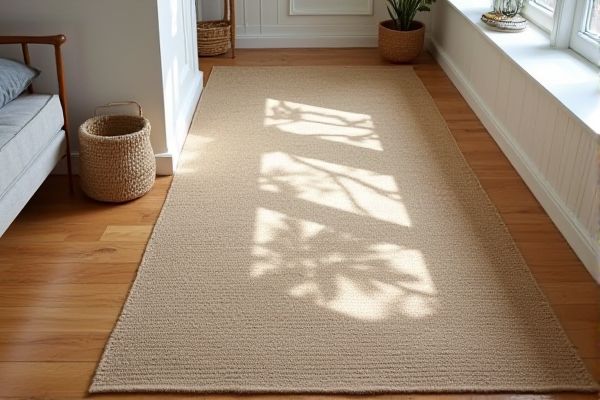
Soft runners offer a plush, cushioned feel ideal for comfort and quiet footsteps, while jute runners provide a natural, eco-friendly option with a textured, rustic look and durable construction. Explore the full article to discover which runner best suits your style and practical needs for your space.
Table of Comparison
| Feature | Soft Runner | Jute Runner |
|---|---|---|
| Material | Synthetic fibers or cotton blend | Natural jute fiber |
| Texture | Soft, plush | Coarse, rustic |
| Durability | Moderate to high | High, strong natural fiber |
| Maintenance | Easy to clean, machine washable | Requires gentle cleaning, air dry |
| Appearance | Varies widely, vibrant colors | Earthy tones, natural look |
| Eco-friendliness | Depends on material, often less eco-friendly | Biodegradable, eco-friendly |
| Usage | Indoor, living rooms, bedrooms | Indoor or covered outdoor areas |
| Price Range | Moderate | Low to moderate |
Introduction to Soft Runners and Jute Runners
Soft runners offer a plush, comfortable texture ideal for creating a cozy atmosphere in your living spaces, often made from synthetic fibers or wool that provide durability and stain resistance. Jute runners, crafted from natural plant fibers, bring an eco-friendly, rustic charm with their coarse texture and earthy tones, perfect for adding organic warmth to hallways or entryways. Choosing between the two depends on your preference for softness versus natural sustainability in floor coverings.
Material Composition: Soft Runner vs Jute Runner
Soft runners are typically crafted from synthetic fibers like polyester or nylon, offering a smooth texture and enhanced durability suited for high-traffic areas. Jute runners are made from natural plant fibers, providing an eco-friendly option with a coarse, rustic appearance and a biodegradable composition. Choosing between the two depends on your preference for comfort, maintenance needs, and environmental impact.
Comfort and Texture Comparison
Soft runners offer a plush, cushioned feel that enhances comfort underfoot, making them ideal for areas where you spend a lot of time standing or walking. Jute runners provide a natural, coarse texture with a firm grip, suitable for adding rustic charm and durability but less softness. Your choice depends on whether you prioritize a cozy, soft surface or a sturdy, eco-friendly option with a textured finish.
Durability and Longevity
Soft runners, typically made from synthetic fibers like polyester or nylon, offer excellent durability and resistance to wear, making them ideal for high-traffic areas while maintaining their color and texture over time. Jute runners, crafted from natural plant fibers, provide a more eco-friendly option but tend to be less durable due to their susceptibility to moisture and fraying, which can shorten their lifespan in busy environments. Choosing between the two depends on balancing the need for long-lasting performance with preferences for natural materials and environmental sustainability.
Maintenance and Cleaning Requirements
Soft runners typically require regular vacuuming and occasional spot cleaning to maintain their appearance, while jute runners demand more careful handling due to their natural fibers, which can be prone to moisture damage and staining. You should avoid using excessive water on jute runners, opting instead for dry cleaning methods or gentle brushing to extend their lifespan. Soft runners offer easier maintenance for high-traffic areas, whereas jute runners need more delicate care to prevent fraying and discoloration.
Aesthetic Appeal and Style Options
Soft runners offer a wide variety of vibrant colors and intricate patterns, enhancing modern and contemporary interior styles with their plush texture and rich visual depth. Jute runners provide a natural, earthy aesthetic characterized by coarse fibers and neutral tones, making them ideal for rustic, coastal, and bohemian decor schemes. The contrast between soft runner's luxurious feel and jute runner's organic simplicity caters to diverse style preferences and design atmospheres.
Eco-Friendliness and Sustainability
Soft runners made from natural fibers like cotton or bamboo offer excellent eco-friendliness due to their biodegradable properties and sustainable harvesting methods. Jute runners, sourced from fast-growing jute plants, are highly sustainable, requiring minimal water and pesticides, which significantly reduces their environmental impact. Choosing a jute runner supports eco-conscious decisions by promoting renewable resources and reducing your carbon footprint in home decor.
Slip Resistance and Safety
Soft runners often feature rubber or latex backing, providing superior slip resistance on various flooring surfaces, enhancing safety by minimizing the risk of falls. Jute runners typically lack an anti-slip backing, making them more prone to shifting and sliding, which can increase the likelihood of accidents. For environments prioritizing slip resistance and safety, soft runners with non-slip materials are the recommended choice.
Best Uses and Placement in Home Décor
Soft runners excel in high-traffic areas like hallways and living rooms due to their plush texture and noise reduction capabilities, making them ideal for creating cozy, inviting spaces. Jute runners are perfect for entryways, kitchens, and dining rooms where durability and natural, rustic aesthetics are desired, as they offer eco-friendly, stain-resistant surfaces. Both materials enhance home decor by complementing various design styles; soft runners suit contemporary and traditional interiors, while jute runners emphasize bohemian and coastal themes.
Price Point and Value for Money
Soft runners typically have a lower price point than jute runners, making them a budget-friendly option for quick decorative updates. Jute runners offer greater value for money due to their durability, natural texture, and eco-friendly appeal, which enhance longevity and aesthetic appeal in high-traffic areas. Your choice should balance immediate cost savings with long-term durability and design impact.
 homyna.com
homyna.com